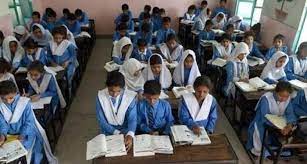The relationship between poverty and education is complex and multifaceted, particularly in Pakistan because of its varied socioeconomic environment. Analyzing data from all provinces provides a nuanced perspective on the potential for progress and obstacles in breaking this cycle.
Poverty significantly impacts education, creating a cycle that is difficult to break. Children from low-income households often struggle to balance education with survival due to lack of resources and opportunities. High dropout rates, difficulty in accessing reputable institutions, and a shortage of supplies like technology and textbooks are common consequences. The stress and unpredictability of poverty can also hinder concentration and study.
Education is a powerful tool in breaking the poverty cycle and creating a brighter future for individuals and communities. It equips individuals with knowledge and skills that lead to better job opportunities, higher income levels, and better living conditions. Education also promotes social mobility and reduces inequality by providing equal opportunities for all, regardless of socio-economic background.
Pakistan with more than 250 million people, struggles with extreme poverty. According to the Pakistan Social and Living Standards Measurement Survey (PSLM) 2022-23, 31.3 percent of the population lives below the poverty line. However, beneath this national average lie significant regional disparities. Provinces like Balochistan and Khyber Pakhtunkhwa (KP) face disproportionately high poverty rates, with 71.4 percent and 35.7 percent, respectively, compared to Punjab’s 18.3 percent and Sindh’s 29.6 percent. These regional disparities extend to educational indicators as well. Despite efforts to improve access to education, Pakistan struggles with alarmingly high out-of-school children rates, particularly in Balochistan and KP.
According to the Annual Status of Education Report (ASER) 2022, Balochistan has the highest proportion of out-of-school children aged 6-16 at 47.2 percent, followed by KP at 34.6 percent, while Punjab and Sindh fare relatively better at 19.6 percent and 25.3 percent, respectively.
The quality of education also varies significantly across provinces, with rural areas bearing the brunt of inadequate infrastructure, poorly trained teachers, and outdated curricula. ASER data reveals that learning outcomes remain dismal, with a large proportion of children in Pakistan failing to achieve basic proficiency in reading and arithmetic. Again, Balochistan and KP exhibit the lowest learning levels, with Punjab and Sindh showing slightly better results, albeit still far from satisfactory.
Poverty exacerbates these challenges and creates additional barriers to accessing quality education. Families living below the poverty line struggle to afford school fees, books, and uniforms, forcing children to drop out of school and contribute to household incomes through labour or domestic work. This phenomenon is particularly pronounced in rural areas, where poverty rates are higher, and educational infrastructure is often lacking.
Moreover, poverty intersects with other social determinants, such as gender, ethnicity, and disability, further marginalizing vulnerable populations and hindering their access to education. Girls, for instance, are disproportionately affected by poverty, with cultural norms and economic constraints often prioritizing boys’ education over girls. Similarly, children from minority ethnic groups and those with disabilities face additional barriers to accessing quality education, perpetuating cycles of exclusion and marginalization.
While poverty poses significant challenges to education in Pakistan, education also holds the promise of breaking the cycle of poverty by equipping individuals with the knowledge, skills, and opportunities to improve their socio-economic status.
Fostering community engagement and establishing a robust monitoring and evaluation system are vital for tracking progress. Forming partnerships with the private sector, civil society organizations, and international donors can leverage resources and expertise for sustainable development efforts. With these concerted efforts, Pakistan can work towards a future where education becomes a powerful tool for breaking the cycle of poverty and fostering inclusive development.
Studies have shown that each additional year of schooling correlates with higher earnings and improved job prospects, highlighting the transformative potential of education in lifting individuals out of poverty. However, realizing this potential requires concerted efforts to address the structural inequalities that perpetuate poverty and educational disparities in Pakistan. It demands targeted interventions that prioritize marginalized communities and ensure equitable access to quality education for all.
Investments in educational infrastructure, teacher training, curriculum reform, and social protection programs are essential components for enhancing educational opportunities. To effectively break the cycle of poverty and improve education, a comprehensive, multi-sectoral approach is necessary. This approach must tackle the root causes of poverty, including economic inequality, social exclusion, and limited access to basic services. Collaboration among government agencies, civil society organizations, and the private sector is crucial for designing and implementing strategies that address both poverty and educational disparities concurrently.
Understanding the intricate relationship between poverty and education in Pakistan requires a nuanced perspective. Analyzing data from across the provinces reveals the disparities and challenges hindering progress towards equitable education. To advance, prioritizing investments in education, particularly in marginalized regions, is paramount. Adopting a holistic approach that addresses the underlying drivers of poverty and educational inequality is crucial.
Developing a robust policy framework aligned with international best practices and allocating financial resources to support these initiatives are essential steps. Prioritizing infrastructure development, such as schools and facilities, along with ensuring access to clean water, can significantly improve educational outcomes. Investing in teacher training programs enhances teaching effectiveness, while curriculum reform prepares students for the workforce. Implementing access and equity policies ensures that education is accessible to all segments of society.
Fostering community engagement and establishing a robust monitoring and evaluation system are vital for tracking progress. Forming partnerships with the private sector, civil society organizations, and international donors can leverage resources and expertise for sustainable development efforts. With these concerted efforts, Pakistan can work towards a future where education becomes a powerful tool for breaking the cycle of poverty and fostering inclusive development.























